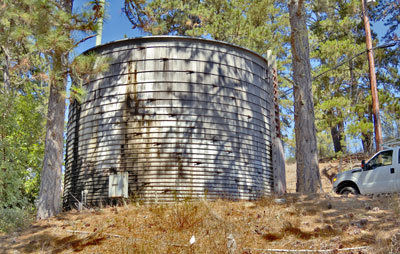
Six local water agencies — San Lorenzo Valley, Scotts Valley, Mount Hermon, Lompico, Santa Cruz and Soquel Creek — are seeking a multimillion-dollar grant to tie their water systems together in case of disaster.
The agencies partnered to apply last week for $9.99 million from the California Department of Public Health that would pay for more than half the project’s costs. The water districts would foot the remainder of the estimated $18.9 million bill.
Charlie McNiesh, the manager of Scotts Valley Water District, said the goal is to share resources and work together more closely. That should ensure, for example, that residents throughout the area have access to water in an emergency.
“It’s been a long process,” McNiesh said. “For decades, water districts (in California) tried to be independent, but they have realized that cooperation is necessary.”
Latest application ‘most promising’
The recent application is the third the districts have submitted for a Proposition 50 grant to create a regional intertie.
Proposition 50, the Water Security, Clean Drinking Water, Coastal and Beach Protection Act passed by California voters in 2002, made available $50 million for water security among $3.44 billion in bond money set aside for statewide water projects.
The districts, led by Scotts Valley, submitted less detailed applications in 2004 and 2007 but were not awarded funding. The districts also unsuccessfully applied for a separate U.S. Bureau of Reclamation grant several years ago.
In July, however, officials with the Department of Public Health asked the districts to resubmit their grant application. That’s reason for confidence, according to John Ricker, director of the Santa Cruz County Resources Division.
“This the most promising funding yet,” Ricker said. “In this case, the state kind of came to us.”
The grant application prepared by Kennedy/Jenks Consultants of Palo Alto includes a detailed technical report that includes pump sizes and specific mapping of the proposed connections between the districts. Completing the application cost about $100,000, McNiesh said.
San Lorenzo Valley Water District Manager Jim Mueller is also optimistic, but still cautious.
“Based on all of our conversations (with the Department of Public Health), there is a high probability of this getting funded — but there’s no guarantee,” Mueller said.
Interties could help in emergency
This part of Proposition 50 monies pays for “water security” projects that help ensure drinking water can be delivered by way of treatment, distribution and supply facilities in the event of a natural disaster or intentional contamination.
In such an emergency, water sources in one district could be cut off, leading to the need for potable drinking water delivered from another district.
Connections between independent water systems in Santa Cruz County would mean that water could be shared among all six districts, through water mains and pumps linking them together.
“It could be any natural disaster,” Mueller said. “Mudslides, trees down, the 1989 earthquake, the ’82 or ’86 storms, forest fires — there are all kinds of things that could potentially happen.”
The grant money would also pay for early-warning technology in some areas.
Water network would connect region
Seven major interties would be constructed using grant money.
- Scotts Valley with Santa Cruz: A 12-inch pipeline would be built from near the Scotts Valley Corners along La Madrona Drive to Sims Road, where it would meet Santa Cruz’s system at Brook Knoll Drive.
- Scotts Valley with SLV South: An 8-inch pipeline would cross Lockwood Lane just north of Lockwood Way in Scotts Valley.
- SLV North with SLV South: A 12-inch pipeline would travel down West Zayante Road to Graham Hill Road and then climb Graham Hill to above Santa Cruz County Juvenile Hall.
- SLV South with Mount Hermon: An 8-inch pipeline would parallel Summit Avenue north to the 12-inch pipeline north of Graham Hill Road.
- SLV North with Lompico: An 8-inch pipeline would travel from Zayante Drive up Lake Boulevard.
- SLV North with Felton: An 8-inch pipeline would run along Highway 9 to connect the systems.
- Santa Cruz and Soquel Creek: A 24-inch pipeline would connect to an 18-inch pipeline between DeLaveaga Park and Soquel Creek by way of Soquel Drive.
Districts to share costs
The districts estimate a total cost of $18.99 million to build the seven interties, $9.99 million of which they hope to receive from Proposition 50 funds.
To make up the difference, San Lorenzo Valley has agreed to contribute $4.175 million; Scotts Valley, $890,686; Santa Cruz, $1.28 million; and Soquel Creek, $2.65 million.
Each district’s contribution is proportional to the cost of the project in its jurisdiction. The larger San Lorenzo Valley district will help Mount Hermon and Lompico during the grant process and the project.
Mueller said San Lorenzo Valley would still have $4.5 million remaining in reserves after the project. The large reserve is a result of the sale of the Waterman Gap property —unused land the district owned — in the early 2000s.
The district’s directors are committed to the project, he said.
“I would say the board is enthusiastic,” Mueller said. “It’s a project they support, particularly when we get a large matching grant.”
Action expected quickly
McNiesh and Mueller both expect to receive a response from the Department of Public Health in several months.
In the meantime, the districts have begun environmental studies and work on technical design features of the interties.
“We are starting the survey and design work even before we hear from public health,” McNiesh said.
If the grant is awarded, the districts have six months to complete construction plans and technical reports and set up water-sharing and financial agreements with each other.
The districts would then have a three-year window to build the interties.
To comment, email editor Peter Burke at pe***@*********er.com, call 438-2500 or post a comment at www.pressbanner.com.












